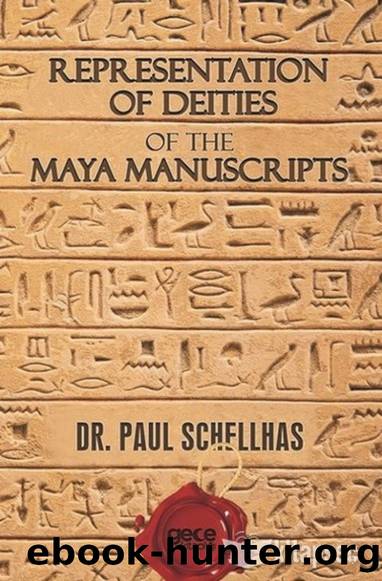Representation of Deities of the Maya Manuscripts by Paul Schellhas

Author:Paul Schellhas [Schellhas, Paul]
Language: eng
Format: epub
ISBN: 9781430499664
Google: WhxnoAEACAAJ
Barnesnoble:
Goodreads: 5929041
Published: 2006-03-18T05:00:00+00:00
I. The Water-Goddess.
In the Dresden manuscript the figure of an old woman, with the body stained brown and claws in place of feet, occurs repeatedly. She wears on her head a knotted serpent and with her hands pours water from a vessel. Evidently we have here a personification of water in its quality of destroyer, a goddess of floods and cloud-bursts, which, as we know, play an important part in Central America. Page 27, of the Codex Troano contains a picture, in which this character of goddess I may be distinctly recognized. In accordance with this character, also on Dr. 74, where something resembling a flood is represented, she wears the cross-bones of the death-god.
The goddess is pictured in the manner described in the following places: Dr. 39b, 43b, 67a and 74. The figure corresponding to her in the Madrid manuscript, in Tro. 27 and 34*c, displays some variations, in particular the tiger claws on the feet and the red-brown color of the body are lacking. But the agreement cannot be questioned, I think, when we recall that the Maya manuscripts doubtless originated in different ages and different areas of civilization, circumstances which readily explain such variations. The goddess distinguished in the Madrid manuscript by symbols of flood and water is doubtless the same as goddess I of the Dresden manuscript described above; her unmistakable character of water-goddess in both manuscripts is in favor of this. In both manuscripts she is invariably distinguished by the serpent on her head, which, as we know, is a symbol of the water flowing along and forming waves.
Strange to say, a fixed hieroglyph of this goddess cannot be proved with certainty. There is some probability in favor of the sign given in Fig. 41. The well-known oblong signs, which Förstemann (Drei Mayahieroglyphen, published in the Zeitschrift für Ethnologie, 1901, pp. 215-221) interprets as the sign for evil days, frequently occur with her. This would be appropriate for the goddess of floods.
In the Dresden manuscript a few similar figures of women are found, who, like goddess I, wear a knotted serpent on the head. Representations of this kind occur in Dr. 9c, 15b, 18a, 20a, 22b and 23b. Whether they are identical with goddess I is doubtful, since there is no symbolic reference to water in these passages. Besides, the hieroglyphs of other known deities occur each time in the above-mentioned places, so that definite mythologic relations must be assumed to exist here between the women repsented and the deities in question. Thus in Dr. 9c we find Dâs sign, in 15b that of H; on 18a, 22b and 23b we see only the general sign for a woman. In Dr. 20a the signs are effaced.
In the Codex Troano goddess I occurs on pp. 25b and 27; there is also a woman with the knotted serpent on her head in Tro. 34*c. In the Codex Cortesianus and in the Paris manuscript these forms are wholly lacking.
Download
This site does not store any files on its server. We only index and link to content provided by other sites. Please contact the content providers to delete copyright contents if any and email us, we'll remove relevant links or contents immediately.
Red by Erica Spindler(12340)
Crooked Kingdom: Book 2 (Six of Crows) by Bardugo Leigh(12175)
Twisted Palace by Erin Watt(11044)
Mindhunter: Inside the FBI's Elite Serial Crime Unit by John E. Douglas & Mark Olshaker(9113)
Fangirl by Rainbow Rowell(9035)
Never let me go by Kazuo Ishiguro(8538)
All the Light We Cannot See: A Novel by Anthony Doerr(8402)
A Man Called Ove: A Novel by Fredrik Backman(8335)
Confessions of an Ugly Stepsister by Gregory Maguire(7797)
The Lover by Duras Marguerite(7762)
Little Fires Everywhere by Celeste Ng(7069)
The Vegetarian by Han Kang(6192)
To All the Boys I've Loved Before by Jenny Han(5719)
The Shadow Of The Wind by Carlos Ruiz Zafón(5555)
On the Yard (New York Review Books Classics) by Braly Malcolm(5454)
Keepsake: True North #2 by Sarina Bowen(5371)
Dancing After Hours by Andre Dubus(5213)
Ken Follett - World without end by Ken Follett(4604)
The Perks of Being a Wallflower by Stephen Chbosky(4541)
